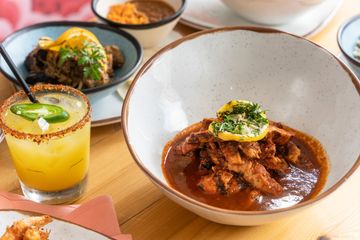Make your evenings lively with happy hour and enjoy classic Mexican drinks
Why Mexican Cuisine Is Famous: Exploring the Cultural Importance Behind the Dishes
Mexican cuisine stands apart for its vibrant flavors and deep cultural origins. The combination of spanish and native influences creates a special culinary identification. Each dish tells a tale of party, area, and custom. Active ingredients like corn and chili peppers play vital roles in shaping these narratives. To recognize the full significance of these cooking techniques, one should check out the layers of background and significance that improve every bite. What lies underneath the surface of this precious food?
The Historical Roots of Mexican Cuisine
Although Mexican cuisine is typically celebrated for its vibrant tastes and varied ingredients, its historical origins run deep, mirroring an abundant tapestry of social impacts. Originating from old Mesoamerican civilizations, such as the Aztecs and Mayans, Mexican food progressed with centuries of farming methods that integrated neighborhood crops like maize, beans, and chili peppers. The arrival of Spanish colonizers in the 16th century presented new ingredients, consisting of dairy products, pork, and rice, which integrated aboriginal practices to develop distinct culinary combinations. This blend of influences not just formed the recipes however likewise stood for the social and social characteristics of the moment. Throughout the years, regional variants arised, affected by location, environment, and regional custom-mades. Mexican cuisine stands as a representation of its historical journey, personifying the strength and versatility of its individuals while commemorating their heritage through food.
Regional Diversity and Its Influence on Flavors
Regional variety plays a necessary role in shaping the tastes of Mexican cuisine, with each location contributing special active ingredients based upon local agriculture and custom. Typical food preparation methods even more boost these flavors, showing the customizeds and histories of individuals. In addition, the varying environments throughout Mexico influence which components grow, resulting in distinctive local dishes that celebrate the nation's culinary splendor.
Special Components by Area
Mexican cuisine showcases an amazing selection of unique ingredients that differ substantially across its varied areas, each contributing unique tastes and cooking strategies. In the coastal areas, fish and shellfish such as shrimp and fish are staples, usually combined with tropical fruits like mango and coconut. The central highlands are recognized for their rich range of beans, corn, and squash, forming the basis of numerous conventional meals. In the Yucatán Peninsula, achiote and sour oranges convey an one-of-a-kind flavor profile, while the north areas prefer beef and wheat-based meals, reflecting the impact of neighboring societies. Each region's environment and location form the regional ingredients, producing a vivid tapestry of flavors that highlight Mexico's abundant cooking heritage.

Conventional Food Preparation Strategies
The varied components located throughout Mexico not just shape the dishes however additionally affect the traditional cooking methods utilized in each region. In Oaxaca, the use of a rock mortar and pestle, recognized as a "metate," is common for grinding corn and spices to produce masa and mole. On the other hand, seaside areas frequently utilize barbecuing and steaming methods to prepare seafood, showing their accessibility to fresh catch. The highlands might stress slow-cooking approaches, such as barbacoa, where meats are covered in maguey leaves and buried in the ground. Each strategy is deeply rooted in the neighborhood society, showcasing the value of custom while boosting the distinctive flavors that identify Mexican food throughout diverse landscapes.
Climate's Flavor Influence
Although climate varies considerably across Mexico, it plays a necessary role fit the flavors and ingredients that define the country's food. Different regions experience unique weather condition patterns, affecting the farming output and cooking methods. As an example, the dry north is recognized for its hearty meats, while the rich south deals an abundance of tropical vegetables and fruits. Coastal areas benefit from fresh fish and shellfish, which ends up being a staple in their dishes. In addition, the highlands create unique herbs and flavors that add to local specialties. This climatic diversity not only improves the flavor accounts of Mexican food but additionally reflects the social identity of each region, showcasing the deep link in between the atmosphere and culinary heritage.
The Function of Components in Culinary Identification
Necessary to understanding culinary identity, the components of a food reveal deep social links and historical stories. In Mexican food, staples such as corn, beans, and chili peppers offer not only as foundational elements yet also as symbols of resilience and adjustment. Corn, for example, is sacred, showing its significance to indigenous societies and farming techniques. The range of beans showcases the country's biodiversity, while chili peppers add depth and warm, standing for local variations and culinary creative thinking.
These components are linked with rituals, customs, and local custom-mades, highlighting the relevance of location fit culinary identification. The assimilation of natural herbs like cilantro and flavors such as cumin additional enriches the taste profile, demonstrating the impact of both aboriginal practices and early american backgrounds. Jointly, these parts develop a vibrant tapestry that reflects the complexities of Mexican culture, making its food an effective expression of identity and heritage.
Standard Food Preparation Methods and Their Relevance
Standard cooking strategies in Mexican food offer as a vital web link to the nation's heritage, maintaining ancient techniques passed down via generations. These methods not only show local diversity however likewise boost the distinct flavors that define the cuisine. Comprehending their relevance discloses the social richness embedded in every dish.
Ancient Methods Maintaining Heritage
While modern-day culinary techniques have actually transformed the landscape of Mexican cuisine, old approaches remain a necessary web link to the country's rich heritage. Techniques such as nixtamalization, the procedure of treating corn with lime pizza places near me to boost its nutritional worth, have been crucial in forming traditional dishes. Making use of clay pots and rock mortars, referred to as molcajetes, likewise mirrors the focus on authenticity and flavor that has been passed down through generations. These techniques not just preserve the integrity of ingredients however also embody communal values and cultural techniques. By proceeding to use these old strategies, contemporary Mexican cooks keep a connection to their ancestors, guaranteeing that the cookeries continue to be lively and reflective of the country's varied history.
Regional Techniques and Flavors
As diverse as its landscapes, Mexican food is defined by a myriad of local strategies and flavors that show the distinct social influences and local active ingredients of each area. In Oaxaca, making use of the comal for cooking tortillas demonstrates a practice passed down via generations, while the Yucatán region showcases the slow-cooking method called cochinita pibil, highlighting marinaded pork covered in banana leaves. Coastal areas highlight fish and shellfish prep work, with techniques like ceviche showing spanish and indigenous impacts. Each area's distinctive seasonings, such as the great smoky chipotle from Veracruz or the vivid chilies from Puebla, add to an abundant tapestry of flavors - lunch and dinner. These standard techniques not just enhance culinary variety but additionally function as a reflection of the resilience and imagination of Mexican culture
Celebrations and celebrations: Food as a Social Expression
Celebrations and festivities in Mexico are usually noted by an array of vibrant dishes that show the country's rich cultural heritage. Traditional meals, such as tamales during Día de los Muertos and pozole during Independence Day, showcase local ingredients and cooking approaches, representing browse around here area and domestic bonds. Food becomes a tool for narration, with each dish lugging historical relevance and local identifications.
Along with the recipes themselves, the rituals surrounding food preparation and consumption play a crucial function in these events. Family members gather to develop intricate dishes, fostering connections and protecting customs gave with generations. The communal nature of these culinary methods highlights the importance of sharing food as an expression of love and unity. Via these joyful gatherings, Mexican food goes beyond mere nourishment, working as a cultural symbol that celebrates heritage, spirituality, and the happiness of togetherness.
International Impact and Acknowledgment of Mexican Gastronomy
Exactly how has Mexican gastronomy gained such extensive honor all over the world? The response depends on its lively flavors, varied ingredients, and abundant cultural heritage that resonate internationally. Acknowledged by UNESCO as an Abstract Cultural Heritage of Humankind, Mexican food showcases an one-of-a-kind mix of spanish and indigenous influences, making it distinct and appealing.
Restaurants focusing on Mexican meals have proliferated internationally, introducing genuine tastes such as mole, tacos, and tamales to diverse tastes. The appeal of Mexican food has actually likewise been boosted by celeb chefs and food preparation shows, which highlight its culinary methods and practices.
Additionally, food festivals and cultural events celebrate Mexican gastronomy, further elevating its condition on the world stage. Because of this, Mexican cuisine goes beyond boundaries, fostering appreciation for its historic value and culinary artistry, ensuring its enduring influence in the international culinary landscape.
Frequently Asked Questions
What Are the Health Conveniences of Typical Mexican Dishes?
Traditional Mexican meals use various health and wellness advantages, consisting of high fiber web content from beans and veggies, healthy fats from avocados, and necessary nutrients from spices. These ingredients add to improved digestion, heart wellness, and total wellness.

Exactly How Can I Recreate Genuine Mexican Recipes in the house?
To recreate genuine Mexican dishes at home, one ought to source fresh ingredients, make use of typical cooking strategies, discover regional variations, and follow reputable recipes while welcoming the cultural nuances and dynamic tastes inherent in Mexican cuisine. (churros)
What Role Do Flavors Play in Mexican Food Preparation?
Spices are necessary in Mexican food preparation, enhancing tastes and fragrances. They provide depth and complexity to meals, reflecting local diversity. Typical flavors like chili, cumin, and oregano add to the vibrant, bold profiles characteristic of Mexican food.
Are There Vegetarian or Vegan Options in Mexican Food?
Yes, Mexican food supplies many vegetarian and vegan alternatives. Recipes such as chiles rellenos, nopales, and various bean prep work showcase the abundant flavors and home components available, making it obtainable for those following plant-based diet plans.
How Has Mexican Cuisine Influenced Various Other Global Foods?
Mexican food has greatly influenced worldwide foods through the introduction of components like corn, beans, and chili peppers, inspiring combination meals and boosting flavor profiles in different cooking traditions, especially in the United States and Latin America.
Mexican cuisine stands out for its vibrant flavors and deep cultural origins. Mexican food is frequently celebrated for its varied active ingredients and dynamic tastes, its historical origins run deep, mirroring an abundant tapestry of social impacts. Regional diversity plays a necessary role in forming the flavors of Mexican cuisine, with each area contributing unique components based on regional farming and tradition. Mexican cuisine showcases an exceptional variety of distinct active ingredients that vary considerably throughout its varied areas, each adding culinary strategies and unique tastes. As diverse as its landscapes, Mexican food is identified by a myriad of regional methods and flavors that reflect the distinct social impacts and regional components of each area.